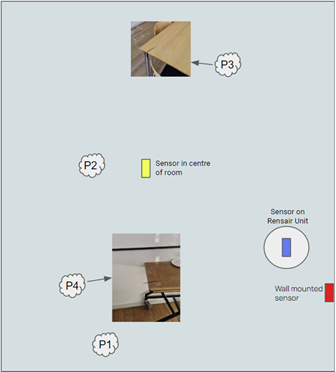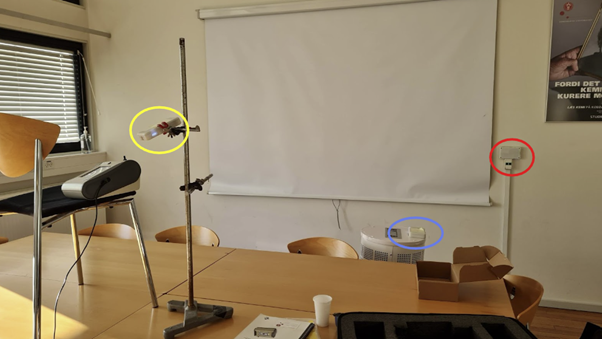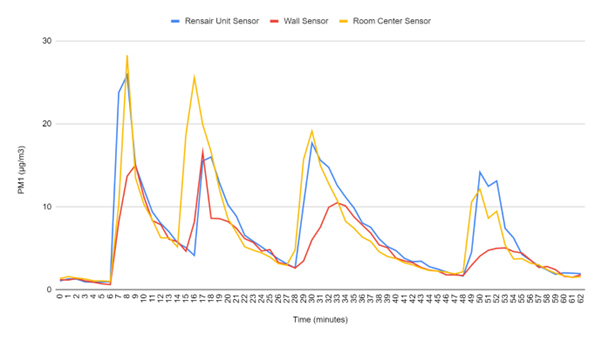Indoor Air Quality Sensors

ABSTRACT
The increased awareness of the importance of good Indoor Air Quality (IAQ) and indoor air quality products, as well as the need to optimise mechanical ventilation rates to deliver good IAQ, have both led to increased demand for IAQ data measured by air sensors. There is understandably a lot of discussion about the varying quality of different sensors and the range of pollutants that are measured, but the importance of the placement of the sensor in a room is often neglected.
To demonstrate the importance of the air sensor placement, Rensair conducted a simple trial in a ventilated furnished room, measuring introduced airborne pollutants with three sensors installed in different locations.
The resulting data showed that even in a ventilated indoor space, the wall mounted sensor measured only half of the pollutants registered by the sensor placed in the centre of the room. This significant variance in measurements highlights the importance of the location of the sensor to accurately measure the Indoor Air Quality, both to ensure a safe environment and to regulate the correct amounts of ventilation.
IMPORTANCE OF AIR SENSOR PLACEMENT
The correct placement of an indoor air quality (IAQ) sensor is important for a few reasons:
Accuracy: An IAQ sensor is designed to measure the concentration of Particulate Matter (PM) pollutants or gases in the air. To accurately measure the concentration of pollutants in the air that people are breathing, a sensor has to be placed in the right location. If the sensor is incorrectly located, it may not accurately reflect the air quality in the space, leading to incorrect measurements and a false sense of security. Furthermore, if the mechanical ventilation rate is dependent on the data from the sensor, inaccurate measurement will lead to incorrect ventilation rates (typically leading to under-ventilation).
Identifying sources: Placing an IAQ sensor in the right location can help identify the sources of pollution in a room. For example, if a sensor is placed near a gas stove, it can detect the amount of carbon monoxide being produced by the stove. This information can help people take appropriate measures to reduce exposure to pollutants.
Monitoring effectiveness of interventions: IAQ sensors can be used to monitor the effectiveness of interventions designed to improve indoor air quality, such as opening windows, turning on air purifiers, or using ventilation systems. Placing sensors in the right location can help determine if the interventions are having the desired effect in keeping pollutants low and CO2 within appropriate thresholds.
INDOOR AIR FLOW
Air can move freely around a room to some extent, but the degree to which it can move depends on a variety of factors, including the size and layout of the room, the temperature and humidity of the air, the presence of obstacles such as furniture or walls, and the presence of fans or other sources of air movement.
In general, air moves from areas of higher pressure to areas of lower pressure, and the movement of air within a room is often influenced by natural convection, which occurs when warm air rises and cool air sinks. This can create a natural circulation of air within the room, although the movement of air can be slowed or blocked by obstacles such as walls, furniture, or people.
The movement of air within a room can be influenced by fans or other mechanical sources of air movement, such as air conditioning systems or ventilation systems. These can be used to help distribute air more evenly throughout the room or to increase the flow of fresh air into the space.
There can also be areas in a room where air is stagnant with little movement. This can be caused by a variety of factors, such as the presence of obstacles, lack of ventilation, or temperature gradients. For example, air can become stagnant near walls, in corners or alcoves where there is little natural air movement or in areas that are blocked by large pieces of furniture or other obstructions.
Air can also become stagnant in rooms with poor ventilation, which can lead to the build-up of pollutants or excess humidity. This lack of ventilation can lead to a build-up of pollutants, which can negatively impact indoor air quality and may cause health problems for occupants. In addition, stagnant air can create hot or cold spots in a room, leading to discomfort or even thermal discomfort.
Placing an IAQ sensor in an area with stagnant air will give an inaccurate reading of the air quality of that indoor space.
Overall, while air can move freely around a room to some extent, its movement is often influenced by a variety of factors, and it may be necessary to use mechanical means to optimise air flow and ensure adequate ventilation. The exact placement of an IAQ sensor needs to be carefully considered so that it is not installed in an area of stagnant air.
TRIAL TO MEASURE AIR POLLUTANTS WITH AIR SENSORS AT DIFFERENT LOCATIONS
The Rensair R&D team conducted a trial to measure Indoor Air Quality by using three high quality air sensors positioned in different locations inside the room. The sensors measured PM1 and PM2.5 readings.
- The room had tables and chairs, so furniture that could obstruct the air flow.
- The room benefitted from mechanical ventilation.
- Pollutants were introduced in four different locations (P1, P2, P3 and P4).
- An IAQ sensor was located on a wall, another in the exact centre of the room and the final one on the top of a Rensair air purifier that was close to a wall.


TRIAL RESULTS
The chart below shows the PM1 measurements, in microgram/m3 (µg/m3), taken by each of the three sensors over an hour as pollutants were introduced over time in various locations in the room.

The data from the measurements show that:
- the sensor at the centre of the room measured the most pollutants.
- the measurements taken by the air sensor placed on the Rensair units were very similar to sensor placed in the centre of the room, except on the introduction of the second pollution.
- the wall mounted sensor always measured far less pollution than the wall sensor (on average the PM1 readings were ~50% less).
- the wall sensor’s pollution readings were delayed compared to those from the sensor placed in the middle of the room and that placed on the Rensair unit.
The reason why the data from the sensor placed on the Rensair unit was similar to that of the sensor in the centre of the room is because a Rensair unit creates effective air circulation inside a room (verified by independent tests). They inhale air at the top of the unit in a 360 degree hemispherical action, and exhale air at the bottom (*). The result is that a unit placed on a Rensair unit will give an accurate reading of the indoor air quality.
CONCLUSION
To measure the IAQ of a room properly, a sensor should be placed in the correct location to ensure that it accurately measures the concentration of pollutants in the air that people are breathing, and not in a place where there is risk of stagnant air.
Alternatively, if located on a wall, the sensor should have the means to create good air circulation to ensure that it is not measuring the air in a stagnant zone.
The importance of the location of the air sensor cannot be underestimated with respect to Smart Demand Controlled Ventilation and mechanical ventilation that is adjusted according to live measurements of indoor air quality. As can be seen from the results in the chart above, taken in a ventilated room, a system that depended on the readings of the wall mounted sensor would have under ventilated the room, having registered that the pollution was only half of the real actual level.
Sensors should also be located to allow for free air flow to the sensor. Avoid placement near high voltage power lines, which may create electronic interferences.
As with outdoor sensors, it is ideal to place indoor sensors near the typical breathing zone height (3 – 6 ft). Sensors should be placed away from air pollution sources, like a toaster, and air pollution sinks, like air cleaners, to get a more representative measure of indoor air quality. Sensors should have free air flow and not be placed behind furniture or tucked away in corners. Windows, doors, and heating, ventilation, and air conditioning (HVAC) ducts can introduce rapidly changing temperature and relative humidity conditions, which may adversely impact some sensors. Additionally, air quality conditions near doors, windows, and duct inlets or exits may be overly influenced by external sources and not be representative of average indoor concentrations.
______________________________________________________________________________________________________
(*) CFD studies show that this combined air flow creates a toroidal air circulation in a room – indeed, independent tests show that a Rensair unit is effective at cleaning air independent of where the unit is placed in a room.
Frequently Asked Questions
How Do Indoor Air Quality Sensors Operate?
Indoor Air Quality (IAQ) sensors track harmful pollutants and environmental factors within buildings, including temperature, humidity, carbon dioxide (CO2), particulate matter (PM2.5, PM10), and volatile organic compounds (VOCs). These sensors identify the sources of pollution & and help with the implementation of air quality interventions.
What is the importance of air sensor placement?
The correct placement of an indoor air quality sensor is important for accurate measurement of pollutants in the air, identify the sources of pollution in the room & monitoring the effectiveness of interventions.
Why is Indoor Air Quality Important?
Indoor air pollution can be ten times worse than outdoor air pollution. Indoor air quality has a greater impact on people’s health and wellbeing. Respiratory problems, allergies, exhaustion, and even chronic illnesses can result from poor IAQ. Indoor air quality sensors monitor harmful pollutants and other physical parameters and flags anomalies or abnormalities to be actioned to ensure a safe environment.
What factors determine the accuracy of an IAQ sensor?
The accuracy of IAQ sensors is determined by the type of sensor, its calibration, and the pollutant being measured.
Why is the accurate placement of air monitoring sensors essential in a room?
Properly positioned sensors avoid areas with unusual airflow patterns, ensuring accurate readings for pollutants, temperature, and humidity. This accuracy allows for timely adjustments in HVAC or air purification systems to maintain optimal indoor air quality.
How Rensair’s Indoor air quality sensor play a significant role?
Rensair uses high-quality sensors that successfully capture harmful pollutants and have the ability to cover a broad region. These sensors can detect dust, pollen, mould, mist, and other particles smaller than 0.3 microns.
How Frequently Should I Update or Calibrate My IAQ Sensor?
The frequency of sensor calibration varies depending on the type of sensor and the manufacturer’s instructions. While some sensors may live longer with less calibration, others may need to be calibrated every six months to a year.
